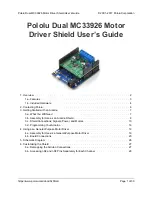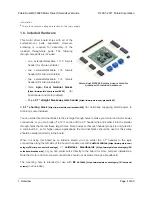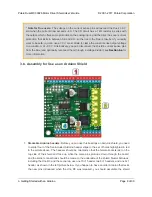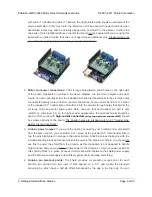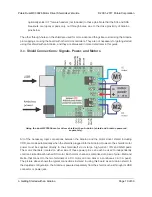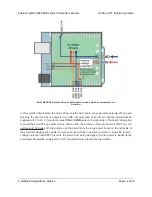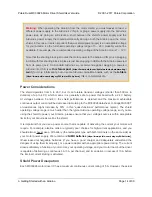
with two 8×1 headers and two 6×1 headers; the right picture below shows an example of the
shield assembled in this way (note: the shield can still be used with newer Arduinos when
assembled in this way, and it is actually plugged into an Uno R3 in the picture). In short, the
two pairs of pins highlighted above in darker red should not be populated if you are using this
board with an older Arduino that does not support these additional pins. Please make sure
you solder the appropriate headers for your particular Arduino!
2.
Motor and power connections:
The six large holes/twelve small holes on the right side
of the board, highlighted in yellow in the above diagram, are the motor outputs and power
inputs. You can optionally solder the included 5mm-pitch terminal blocks to the six large holes
to enable temporary motor and motor power connections, or you can break off a 12×1 section
of the included 0.1″ header strip and solder it into the smaller through-holes that border the
six large motor and motor power pads. Note, however, that each header pin pair is only
rated for a combined 6 A, so for higher-power applications, the terminal blocks should be
used or thick wires with
high-current connectors
[https://www.pololu.com/product/925]
should
be soldered directly to the board. The smaller holes are intended only for 0.1″ header pins,
not
for the terminal blocks!
3.
Arduino power jumper:
If you want the option of powering your Arduino and motor shield
from the same source, you can solder a 2×1 piece of the included 0.1″ male header strip to
two the pins highlighted in orange in the above picture. Shorting across these pins with the
included shorting block will connect the shield power to the Arduino’s VIN pin. You should not
use this to power the shield from the Arduino as this connection is not designed to handle
high currents, and you must never supply power to the Arduino’s VIN pin or power jack while
this shorting block is in place, because it will create a short between the shield power supply
and the Arduino power supply and will likely permanently damage something.
4.
Arduino pin breakout points:
The shield provides a secondary access point for each
Arduino pin, divided into two rows of pins spaced on a 0.1″ grid (unlike the standard
Arduino pins, which have a half-pin offset introduced by the gap in the top row). You can
Pololu Dual MC33926 Motor Driver Shield User’s Guide
© 2001–2017 Pololu Corporation
3. Getting Started with an Arduino
Page 9 of 30

